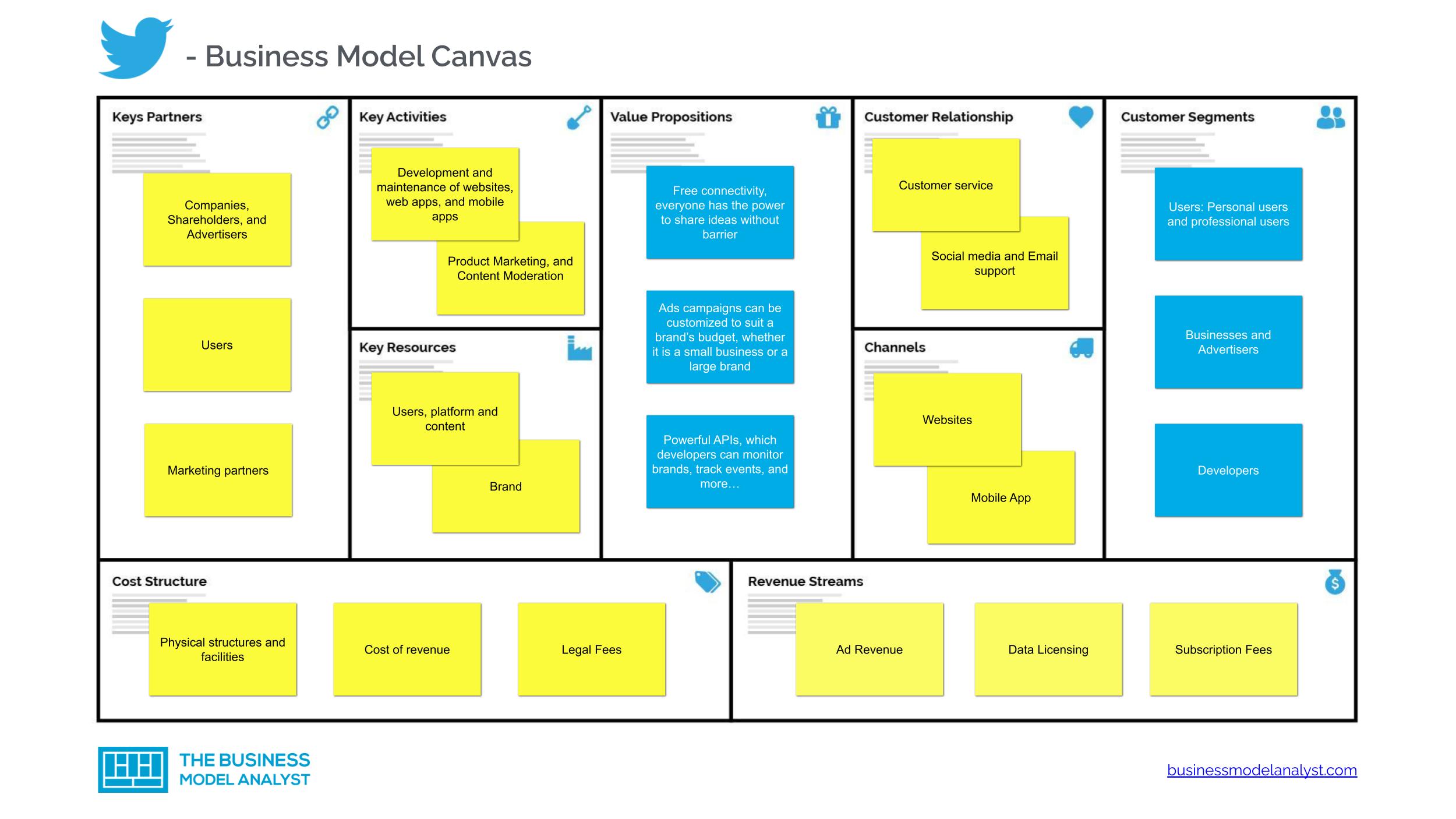Understanding Twitter’s Business Model
Twitter, a social media giant, has evolved significantly since its inception in 2006. With over 440 million monthly active users, the platform has become an essential tool for individuals, businesses, and organizations to share information, connect with others, and stay updated on current events. But have you ever wondered how Twitter earns money? To understand the company’s revenue streams, it’s essential to delve into its business model.
Twitter’s business model is primarily based on advertising, data licensing, and other revenue streams. The company generates revenue by selling advertising space on its platform, licensing its data to third-party companies, and offering various services to businesses and individuals. Understanding these revenue streams is crucial to appreciating Twitter’s financial performance and growth prospects.
Twitter’s advertising platform is designed to help businesses reach their target audience, increase brand awareness, and drive website traffic and sales. The platform offers various ad formats, including promoted tweets, promoted accounts, and promoted trends. Advertisers can target specific audiences based on demographics, interests, keywords, and more. Twitter’s advertising revenue is significant, accounting for the majority of its total revenue.
In addition to advertising, Twitter also generates revenue through data licensing. The company collects and analyzes vast amounts of data on user behavior, including tweets, likes, retweets, and more. This data is valuable to third-party companies, which use it to gain insights into consumer behavior, track market trends, and make informed business decisions. Twitter licenses this data to companies, providing them with valuable information to drive their business strategies.
Twitter’s business model is designed to provide value to both users and advertisers. By offering a platform for users to share information and connect with others, Twitter creates a valuable audience for advertisers. At the same time, the company’s advertising platform provides businesses with a powerful tool to reach their target audience and drive business results. Understanding Twitter
Advertising: The Primary Source of Twitter’s Income
Twitter’s advertising platform is a crucial component of its revenue streams, accounting for the majority of its income. The platform offers a range of ad formats, including promoted tweets, promoted accounts, and promoted trends, which enable businesses to reach their target audience and achieve their marketing objectives. To understand how Twitter earns money through advertising, it’s essential to delve into its ad formats, targeting options, and pricing models.
Twitter’s ad formats are designed to help businesses achieve specific goals, such as increasing brand awareness, driving website traffic, and generating leads. Promoted tweets, for example, allow businesses to promote their tweets to a wider audience, increasing their visibility and engagement. Promoted accounts, on the other hand, enable businesses to promote their Twitter accounts to attract new followers and increase their reach.
Twitter’s targeting options are also a key feature of its advertising platform. Businesses can target specific audiences based on demographics, interests, keywords, and more. This enables them to reach their desired audience and increase the effectiveness of their ad campaigns. Twitter’s targeting options also include lookalike targeting, which enables businesses to target users who are similar to their existing followers or customers.
Twitter’s pricing models are based on a cost-per-engagement (CPE) or cost-per-thousand impressions (CPM) basis. This means that businesses only pay for their ads when they are engaged with or viewed by their target audience. Twitter’s pricing models are designed to provide businesses with a high return on investment (ROI) and to help them achieve their marketing objectives.
Twitter’s advertising revenue is significant, accounting for the majority of its total revenue. In 2020, Twitter’s advertising revenue reached $3.7 billion, representing a 15% increase from the previous year. The company’s advertising revenue is expected to continue growing in the coming years, driven by the increasing demand for digital advertising and the growing popularity of Twitter’s platform.
Understanding Twitter’s advertising platform is essential to understanding how the company earns money. By providing businesses with a range of ad formats, targeting options, and pricing models, Twitter enables them to achieve their marketing objectives and increase their revenue. As the demand for digital advertising continues to grow, Twitter’s advertising revenue is expected to remain a significant component of its revenue streams.
Data Licensing: A Lucrative Revenue Stream
Twitter’s data licensing business is a significant revenue stream for the company, accounting for a substantial portion of its total revenue. Twitter licenses its data to third-party companies, which use this data to gain insights into consumer behavior, track market trends, and make informed business decisions. The company’s data licensing business is a lucrative revenue stream, with a wide range of companies using Twitter’s data to drive their business strategies.
Twitter’s data licensing business includes the licensing of its tweet data, user data, and other types of data. The company’s tweet data is particularly valuable, as it provides insights into consumer behavior, opinions, and trends. Twitter’s user data is also highly valuable, as it provides information on user demographics, interests, and behavior. The company’s data licensing business is a key component of its revenue streams, and it is expected to continue growing in the coming years.
Twitter’s data licensing business is used by a wide range of companies, including market research firms, financial institutions, and media organizations. These companies use Twitter’s data to gain insights into consumer behavior, track market trends, and make informed business decisions. Twitter’s data licensing business is a significant revenue stream for the company, and it is expected to continue growing in the coming years.
The revenue potential of Twitter’s data licensing business is significant, with the company generating hundreds of millions of dollars in revenue from this stream each year. The growth prospects for this revenue stream are also strong, with the demand for social media data expected to continue growing in the coming years. Twitter’s data licensing business is a key component of its revenue streams, and it is expected to continue playing a significant role in the company’s financial performance.
Twitter’s data licensing business is also a key component of its strategy to diversify its revenue streams. By licensing its data to third-party companies, Twitter is able to generate revenue from a wide range of sources, reducing its dependence on advertising revenue. This diversification of revenue streams is expected to help Twitter achieve long-term financial sustainability, and it is a key component of the company’s strategy to drive growth and profitability.
Twitter’s E-commerce and Transactional Revenue
Twitter’s e-commerce and transactional revenue streams are a growing component of the company’s revenue mix. The company has introduced several features to enable e-commerce and transactional activities on its platform, including a shopping cart feature and transactional ads. These features allow businesses to sell products and services directly to Twitter users, providing a new revenue stream for the company.
Twitter’s shopping cart feature allows businesses to tag products in their tweets, enabling users to purchase products directly from the platform. This feature has been successful, with many businesses reporting increased sales and revenue from Twitter. The company’s transactional ads also enable businesses to promote products and services to Twitter users, providing a new revenue stream for the company.
The potential of Twitter’s e-commerce and transactional revenue streams is significant. The company has reported that its e-commerce revenue has grown significantly in recent years, with many businesses using the platform to sell products and services. The growth prospects for this revenue stream are also strong, with the demand for e-commerce and transactional activities on social media platforms expected to continue growing in the coming years.
Twitter’s e-commerce and transactional revenue streams are also expected to have a positive impact on the company’s overall revenue growth. By providing businesses with new ways to sell products and services, Twitter is able to increase its revenue and drive growth. The company’s e-commerce and transactional revenue streams are also expected to help Twitter achieve long-term financial sustainability, by providing a diversified revenue mix.
However, Twitter’s e-commerce and transactional revenue streams also face challenges. The company must compete with other social media platforms, such as Facebook and Instagram, which also offer e-commerce and transactional features. Additionally, Twitter must ensure that its e-commerce and transactional features are secure and trustworthy, to maintain user confidence and drive adoption.
Despite these challenges, Twitter’s e-commerce and transactional revenue streams are expected to continue growing in the coming years. The company’s focus on innovation and user experience is expected to drive adoption and revenue growth, and its diversified revenue mix is expected to help Twitter achieve long-term financial sustainability.
Other Revenue Streams: A Closer Look
Twitter’s other revenue streams include its subscription-based services, such as Twitter Blue, and its revenue from licensing its content to third-party platforms. Twitter Blue is a subscription-based service that offers users additional features, such as the ability to edit tweets and access exclusive content. The service is designed to provide users with a more premium experience, while also generating revenue for Twitter.
Twitter’s revenue from licensing its content to third-party platforms is also a significant revenue stream. The company licenses its content to a wide range of platforms, including news organizations, research firms, and other social media companies. This revenue stream is expected to continue growing, as more and more companies seek to leverage Twitter’s content to drive their own businesses.
Twitter’s subscription-based services, such as Twitter Blue, are designed to provide users with a more premium experience, while also generating revenue for Twitter. The service is expected to be a significant revenue stream for Twitter, as more and more users seek to access exclusive content and features.
Twitter’s revenue from licensing its content to third-party platforms is also expected to continue growing. The company’s content is highly valued by a wide range of companies, and is expected to remain a significant revenue stream for Twitter in the coming years.
Overall, Twitter’s other revenue streams are an important component of the company’s overall revenue mix. By providing users with additional features and services, and by licensing its content to third-party platforms, Twitter is able to generate revenue and drive growth.
Twitter’s other revenue streams are also expected to play a key role in the company’s long-term financial sustainability. By diversifying its revenue streams, Twitter is able to reduce its dependence on advertising revenue, and ensure that it has a stable and sustainable revenue base.
How Twitter’s Revenue Streams Impact its Financial Performance
Twitter’s revenue streams have a significant impact on its financial performance, including its revenue growth, profitability, and cash flow. The company’s diversified revenue mix, which includes advertising, data licensing, e-commerce, and other revenue streams, helps to ensure its long-term financial sustainability.
Twitter’s advertising revenue is the largest contributor to its revenue growth, accounting for the majority of its total revenue. The company’s advertising platform is designed to provide businesses with a range of ad formats, targeting options, and pricing models, which helps to drive revenue growth.
Twitter’s data licensing business is also a significant contributor to its revenue growth, providing a lucrative revenue stream for the company. The company’s data licensing business is expected to continue growing, as more and more companies seek to leverage Twitter’s data to drive their own businesses.
Twitter’s e-commerce and transactional revenue streams are also expected to contribute to the company’s revenue growth, as more and more businesses seek to use the platform to sell products and services. The company’s shopping cart feature and transactional ads are designed to provide businesses with a range of tools to drive sales and revenue.
Twitter’s diversified revenue mix is also expected to help the company achieve long-term financial sustainability. By reducing its dependence on advertising revenue, Twitter is able to ensure that it has a stable and sustainable revenue base.
Twitter’s financial performance is also impacted by its ability to manage its costs and expenses. The company’s cost structure is designed to be flexible and scalable, which helps to ensure that it can manage its costs and expenses effectively.
Overall, Twitter’s revenue streams have a significant impact on its financial performance, and the company’s diversified revenue mix is expected to help it achieve long-term financial sustainability.
Twitter’s financial performance is also expected to be impacted by emerging trends in digital advertising, such as the increasing use of artificial intelligence and machine learning. The company’s ability to adapt to these trends and leverage them to drive revenue growth will be critical to its long-term success.
Challenges and Opportunities in Twitter’s Revenue Streams
Twitter’s revenue streams face several challenges and opportunities that can impact the company’s financial performance. One of the main challenges is the increasing competition from other social media platforms, such as Facebook and Instagram. These platforms have been gaining popularity and have been attracting advertisers and users away from Twitter.
Another challenge facing Twitter’s revenue streams is the impact of regulatory changes. The company has been facing increased scrutiny from regulators over issues such as data privacy and advertising transparency. These regulatory changes can impact Twitter’s ability to generate revenue from its advertising platform.
Despite these challenges, Twitter’s revenue streams also face several opportunities. One of the main opportunities is the growing demand for digital advertising. As more and more businesses shift their advertising budgets to digital platforms, Twitter is well-positioned to benefit from this trend.
Another opportunity facing Twitter’s revenue streams is the growing demand for e-commerce and transactional services. The company’s shopping cart feature and transactional ads are well-positioned to benefit from this trend, and can help Twitter generate additional revenue.
Twitter’s revenue streams also face opportunities from emerging trends in digital advertising, such as the increasing use of artificial intelligence and machine learning. The company’s ability to adapt to these trends and leverage them to drive revenue growth will be critical to its long-term success.
Overall, Twitter’s revenue streams face both challenges and opportunities that can impact the company’s financial performance. By understanding these challenges and opportunities, investors and analysts can better appreciate the company’s revenue potential and growth prospects.
Twitter’s ability to navigate these challenges and opportunities will be critical to its long-term success. The company’s ability to adapt to changing market trends and regulatory environments will be essential in driving revenue growth and maintaining its competitive position in the market.
Conclusion: Unlocking Twitter’s Revenue Potential
In conclusion, Twitter’s revenue streams are a complex and multifaceted aspect of the company’s business model. By understanding the various ways in which Twitter generates revenue, including advertising, data licensing, e-commerce, and other revenue streams, investors and analysts can gain a deeper appreciation for the company’s financial performance and growth prospects.
Twitter’s revenue potential is significant, driven by the growing demand for digital advertising, e-commerce, and data licensing. The company’s ability to adapt to emerging trends in digital advertising, such as the increasing use of artificial intelligence and machine learning, will be critical to its long-term success.
However, Twitter’s revenue streams also face challenges, including the impact of regulatory changes, competition from other social media platforms, and emerging trends in digital advertising. The company’s ability to navigate these challenges and opportunities will be essential in driving revenue growth and maintaining its competitive position in the market.
Overall, Twitter’s revenue streams offer a compelling opportunity for investors and analysts to gain insights into the company’s financial performance and growth prospects. By understanding the various ways in which Twitter generates revenue, investors and analysts can make more informed decisions about the company’s potential for long-term success.
As we have seen, Twitter’s revenue streams are a key component of the company’s business model, and understanding them is essential to appreciating the company’s financial performance and growth prospects. By analyzing the various ways in which Twitter generates revenue, investors and analysts can gain a deeper understanding of the company’s potential for long-term success.
In the end, Twitter’s revenue potential is significant, and the company’s ability to adapt to emerging trends in digital advertising and e-commerce will be critical to its long-term success. By understanding the various ways in which Twitter generates revenue, investors and analysts can make more informed decisions about the company’s potential for long-term success.







